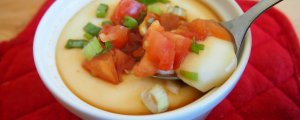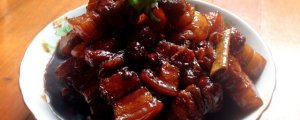
Chives, Haimi, taro, dumplings
(144545 views)
The traditional dumplings are made of wheat flour. The difference is nothing more than making some changes between high gluten flour, rich flour and coarse grain flour. The dumplings I am going to make today do not need flour. They are made of sweet, soft and glutinous taro. Use taro to make dumplings. Every dumpling is full of spirit. It's fragrant and smooth. It's nearly 60. I've eaten 20 by myself, but I'm not satisfied.
Cooking ingredients
Cooking Steps

Step1:Clean the taro and put it in the steaming plat

Step2:Steam in the steamer for 30 minutes at 100 ℃; if the taro is cut into two halves, it can shorten the time; if there is no steamer, there is no problem with the ordinary steamer. The time of steaming depends on the size and firepower of the taro. If the chopsticks can be easily pierced through the thick place, it means they are fully cooked

Step3:When steaming taro, treat the stuffing - proper amount of pork stuffing; clean the leek; wash the Haimi twice, and then soak in clean water. Do not use too much water. You can dilute the meat stuffing. The water soaked in Haimi is very delicious

Step4:Cut the soaked sea rice into pieces, and put it into the meat stuffing with the water soaked in sea rice. Mix well

Step5:Cut the leek into small pieces. Mix it with the meat stuffing of Haimi evenly. Haimi is salty, so add some salt

Step6:The steamed taro is peeled and pressed into fine taro mud with a mud press. Because the taro mud is relatively thin, the potato (potato) starch should be added. The water content of the taro mud is different, so the potato starch should be added one by one

Step7:The mashed taro added with potato starch needs to be kneaded into a dry and hard to disperse ball; I roughly weighed 470g of taro with skin, steamed and peeled to remove the loss. With potato starch, the total weight is 580g, that is to say, about 140g of potato starch is used

Step8:Cover the dough with plastic wrap for 20 minutes. Sprinkle proper amount of potato starch on the dough pad. Rub the dough into long strips, cut them into even sized preparations, and roll them into small round pieces of almost the same thickness. It doesn't matter if there are some small serrations on the edges. They will be neat after kneading

Step9:Put some pork, leek, sea rice stuffing on the round skin

Step10:When the dough is folded in half, it should be pinched tightly. Because the dough lacks gluten, do not pinch the lace like when you pinch the wheat flour dumplings. It can ensure that the leather will not open up or leak the soup after pinching. The wrapped taro dumplings should be covered with fresh-keeping bags to prevent water evaporation

Step11:Boil the taro dumplings in a boiling water pot. The standard for judging whether they are cooked depends on visual inspection. Each dumpling bulges. The skin is boiled to a transparent shape. You can even fish out when you can see the color of the filling

Step12:When cooking dumplings, prepare a bowl of juice - a little vinegar, soy sauce, and chopped shallots. Put a little chili or chili oil on the hot ones

Step13:Put the cooked taro dumplings and soup into a bowl. Make the smooth, tender, fragrant and soft leek, Haimi and taro dumpling
Cooking tips:1. The water content of taro is different, so the amount of potato starch added is also uncertain. Add it one by one, and it can be kneaded into a non dispersive and non stick ball; the skin will not be as flexible as wheat flour. As long as the bag is not broken or leaking, it is OK; 2. When selecting the taro, the appearance is neat, there is no obvious scar. The hand touch is hard and real, and there is weight in the hand. This is more water content Light hands. There's less water here. If you are cooking, you need more water. If you are cooking, you need less water. There are skills in making delicious dishes.
 Chinese Food
Chinese Food












